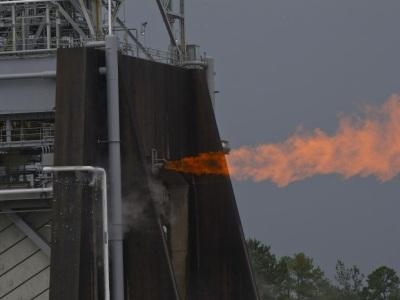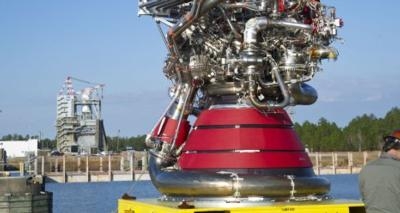Fri, Apr 26, 2013
Pratt & Whitney Rocketdyne Completes J-2X Hot Fire Testing
The last in a series of hot-fire tests on a J-2X engine with a stub-nozzle extension at simulated altitude conditions has been completed by Pratt &Whitney Rocketdyne. This latest chapter in the development of America's next rocket engine paves the way toward full-motion testing of the J-2X engine, which is designed to power humans to Mars. NASA has selected the J-2X as the upper-stage propulsion for the evolved 143-ton Space Launch System (SLS), an advanced heavy-lift launch vehicle.

"This test series with the stub-nozzle extension was very successful," said Walt Janowski, J-2X program manager, Pratt & Whitney Rocketdyne. "We completed all the objectives we set out to accomplish, and acquired important information to help us better understand how the engine will perform during flight – from thrust, hardware durability and combustion stability. We look forward to continuing to work with NASA to provide a safe, reliable transportation system to explore new destinations in space."
In the latest series of tests with the stub-nozzle extension, J-2X Engine 10002 was tested six times for a total of 2,156 seconds on the A-2 test stand at John C. Stennis Space Center in Mississippi. The stub-nozzle extension allows engineers to test the engine in near-vacuum conditions, similar to what it will experience in the extreme environment of space. The next step is to move the engine to the A-1 test stand, where it will be fired to test the range of gimbal motion for its flexible parts. Engine 10002 is the second J-2X development engine built by Pratt & Whitney Rocketdyne for NASA.
The first J-2X engine, Engine 10001, was tested a total of 21 times for more than 45 minutes last year. The J-2X powerpack, which consists of components on top of the engine, was tested separately 13 times for a total of more than 100 minutes at Stennis Space Center. The engines and powerpack were fired at varying pressures, temperatures and flow rates to ensure the engine is ready to support exploration beyond low-Earth orbit, Mars and beyond.
(Images provided by NASA)

More News
He Attempted To Restart The Engine Three Times. On The Third Restart Attempt, He Noticed That Flames Were Coming Out From The Right Wing Near The Fuel Cap Analysis: The pilot repor>[...]
Make Sure You NEVER Miss A New Story From Aero-News Network Do you ever feel like you never see posts from a certain person or page on Facebook or Instagram? Here’s how you c>[...]
From 2009 (YouTube Edition): Leading Air Show Performers Give Their Best Advice for Newcomers On December 6th through December 9th, the Paris Las Vegas Hotel hosted over 1,500 air >[...]
Aero Linx: NASA ASRS ASRS captures confidential reports, analyzes the resulting aviation safety data, and disseminates vital information to the aviation community. The ASRS is an i>[...]
“For our inaugural Pylon Racing Seminar in Roswell, we were thrilled to certify 60 pilots across our six closed-course pylon race classes. Not only did this year’s PRS >[...]
 NTSB Final Report: Rutan Long-EZ
NTSB Final Report: Rutan Long-EZ ANN FAQ: Turn On Post Notifications
ANN FAQ: Turn On Post Notifications Classic Aero-TV: ICAS Perspectives - Advice for New Air Show Performers
Classic Aero-TV: ICAS Perspectives - Advice for New Air Show Performers ANN's Daily Aero-Linx (06.28.25)
ANN's Daily Aero-Linx (06.28.25) Aero-News: Quote of the Day (06.28.25)
Aero-News: Quote of the Day (06.28.25)




